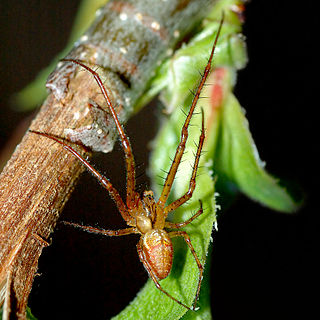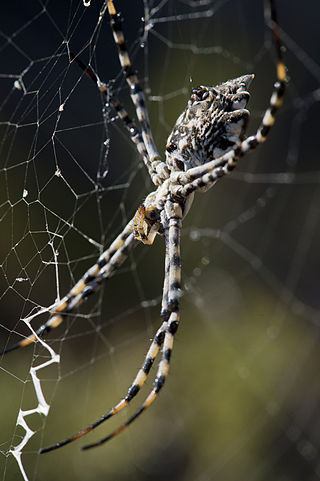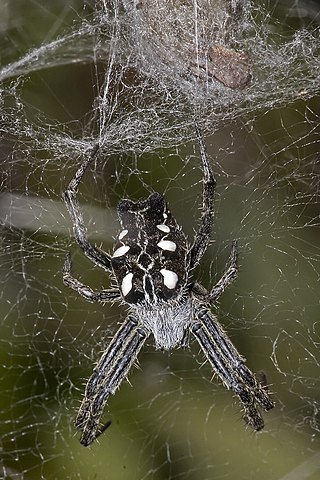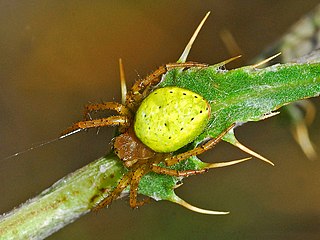
The genus Argiope includes rather large spiders that often have a strikingly coloured abdomen. These spiders are distributed throughout the world. Most countries in tropical or temperate climates host one or more species that are similar in appearance. The etymology of Argiope is from a Latin word argentum meaning silver. The carapace of Argiope species is typically covered in silvery hairs, and when crawling in the sun, they reflect it in a way that gives them a metallic, white appearance.

The Agelenidae are a large family of spiders in the suborder Araneomorphae. Well-known examples include the common "grass spiders" of the genus Agelenopsis. Nearly all Agelenidae are harmless to humans, but the bite of the hobo spider may be medically significant, and some evidence suggests it might cause necrotic lesions, but the matter remains subject to debate. The most widely accepted common name for members of the family is funnel weaver.

Orb-weaver spiders are members of the spider family Araneidae. They are the most common group of builders of spiral wheel-shaped webs often found in gardens, fields, and forests. The English word "orb" can mean "circular", hence the English name of the group. Araneids have eight similar eyes, hairy or spiny legs, and no stridulating organs.

Long-jawed orb weavers or long jawed spiders (Tetragnathidae) are a family of araneomorph spiders first described by Anton Menge in 1866. They have elongated bodies, legs, and chelicerae, and build small orb webs with an open hub with few, wide-set radii and spirals with no signal line or retreat. Some species are often found in long vegetation near water.

Tord Tamerlan Teodor Thorell was a Swedish arachnologist.

A bolas spider is a member of the orb-weaver spider that, instead of spinning a typical orb web, hunts by using one or more sticky "capture blobs" on the end of a silk line, known as a "bolas". By swinging the bolas at flying male moths or moth flies nearby, the spider may snag its prey rather like a fisherman snagging a fish on a hook. Because of this, they are also called angling or fishing spiders. The prey is lured to the spider by the production of up to three sex pheromone-analogues.

Araneus is a genus of common orb-weaving spiders. It includes about 650 species, among which are the European garden spider and the barn spider. The genus was erected by Carl Alexander Clerck in 1757.

Araniella is a genus of orb-weaver spiders first described by R. V. Chamberlin & Wilton Ivie in 1942. The genus includes Araniella cucurbitina, the cucumber green spider.

Aculepeira is a genus of orb-weaver spiders first described by R. V. Chamberlin & Wilton Ivie in 1942.

Araniella cucurbitina, sometimes called the "cucumber green spider", is a spider of the family Araneidae. Araniella cucurbitina is found across Europe, Western Asia, Central Asia and Japan. The cucurbitina in the name comes from the word cucurbit which is a family of plants including cucumbers.
Nephilengys is a genus of tropical spiders of the family Nephilidae, consisting of two currently described species. The genus Nephilingis has been split off from this genus. Both genera have been called hermit spiders from the habit staying in their retreats during the day; the name eunuch spiders has been used for Nephilengys alone. Males may sever parts of their palpal bulbs after copulation.

Argiope lobata is a species of spider belonging to the family Araneidae. It has a wide distribution encompassing the whole of Africa and stretching to southern Europe and into Asia.

Cyrtophora citricola, also known as the tropical tent-web spider, is an orb-weaver spider in the family Araneidae. It is found in Asia, Africa, Australia, Costa Rica, Hispaniola, Colombia, and Southern Europe and in 2000, it was discovered in Florida. C. citricola differs from many of its close relatives due its ability to live in a wide variety of environments. In North America and South America, the spider has caused extensive damage to agricultural operations.
Aculepeira lapponica is an orb-weaving spider found in Sweden, Finland and Russia.
Aculepeira talishia is an orb-weaving spider species found in Turkey, Russia, Georgia and Azerbaijan.

Cyrtophora unicolor is a species of spider of the family Araneidae. It is known as the red tent spider.

Hypsosinga pygmaea is a species of orb weaver in the spider family Araneidae. It is found in North America, Europe, Turkey, Israel, Caucasus, a range from Russia to Central Asia, China, Korea, and Japan.

Aculepeira packardi is a species of orb weaver in the spider family Araneidae. It is found in North America, Russia, China, and Kazakhstan.

Araniella opisthographa is a species of orb weaver in the spider family Araneidae.
















